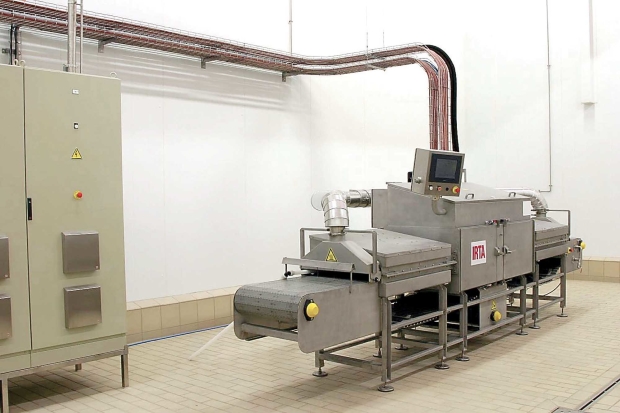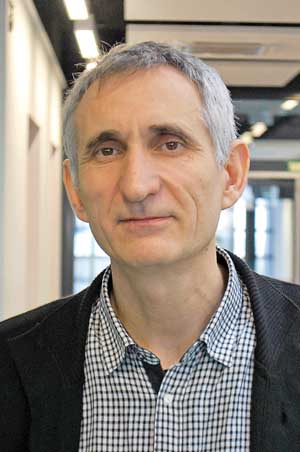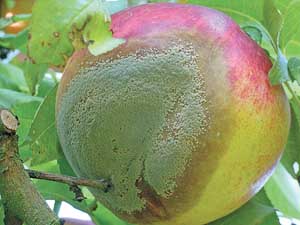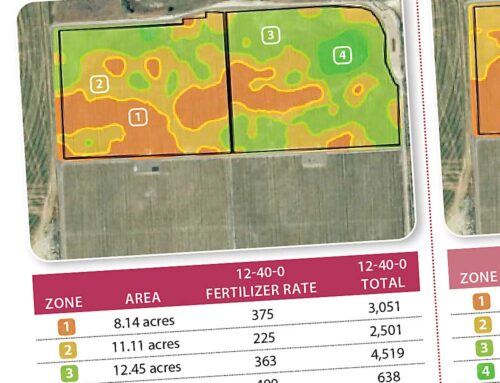
An industrial microwave with a continuous conveyor belt was used for the experiments.Courtesy of Josep Usall
Scientists in Spain have shown that microwaving peaches and nectarines on the packing line could be an effective way to control brown rot.
Brown rot (Monilinia sp.) is a serious postharvest disease of stone fruits worldwide. No fungicides are registered in the European Union for postharvest treatment of stone fruit, so producers have to rely on preharvest fungicide applications and good sanitation practices and avoid wounding the fruit. However, brown rot can still be a problem, reports Dr. Josep Usall, postharvest specialist with the Institute for Food and Agricultural Technology (IRTA) in Leida, Catalonia, Spain, who directed the microwave research.

Dr. Josep Usall, postharvest specialist with IRTA in Spain, heads an effort to control brown rot without fungicides.Courtesy of Josep Usall
“We knew that this microorganism is sensitive to temperature,” he said. “If the peach has been infected in the field and arrives at the fruit processing plant without rotting, it will rot within four days. But if you subject it to this treatment, it will not rot, and the process does not damage the fruit.”
Microwave treatments are used commercially to control pests in grains and stored products, but have not yet been used to control postharvest diseases. Research has previously been done on controlling Botrytis and Penicillium expansum (blue mold) in peaches, but it was done using a household microwave oven.
Researchers from IRTA and the University of Leida used an industrial microwave tunnel with a continuous conveyor belt for their research, in which they showed that brown rot could be controlled without affecting fruit quality.
The tunnel was 6.5 meters (almost 22 feet) long. Fruit were microwaved at powers between 5 and 20 kilowatts for periods ranging from 34 to 120 seconds. Treatment at 5 kW provided no brown rot control, even with the longest exposure time. However, treatment at 10 kW for 100 seconds or 17.5 kW for 50 seconds provided complete control.
Fruit quality
The scientists went on to evaluate the effects of two microwave treatments (10 kW for 95 seconds and 17.5 kW for 50 seconds) on inoculated fruit of different weights and maturity levels and on fruit with natural brown rot infections. They also evaluated the effect of the treatments on fruit quality.
Brown rot control in the largest fruit (weighing about 260 grams, or 9 ounces) was lower than in the smaller fruit. This could be due to the different final temperatures reached by fruit of different weights, with smaller fruit becoming hotter, the researchers report.

No preharvest fungicide applications are allowed in Europe to control brown rot on nectarines and peaches.Courtesy of Josep Usall
Before the experiment, the peaches and nectarines were held at room temperature for one, two, or three days, so that there was a range in maturity, but maturity level did not appear to affect how well the microwave treatment controlled brown rot.
When they evaluated fruit quality, the scientists found that fruit that had been microwaved was firmer than the fruit that had not. Scientists believe that heating the fruit might inactivate hydrolytic enzymes in the cell walls or delay peak production of the ripening hormone ethylene.
Appearance of the fruit was not affected by any of the microwave treatments they evaluated. However, small fruit had some flesh browning, particularly around the stone. This damage may be due to the relatively high internal temperatures in small fruit. In small fruit, weighing 170 to 180 grams (about 6 ounces), the internal temperature varied from 55°C to 63°C (131°F to 154°F), compared with a temperature range of 41°C to 45°C (106°F to 113°F) in large fruit.
The scientists estimated the cost of the electricity needed for such a treatment, based on the prototype microwave equipment they used. With the price of electricity at 0.18 Euros a kilowatt-hour in Spain, the cost ranged between 0.02 and 0.03 Euros per kilogram (1 to 1.5 cents per pound), depending on the treatment. The cost of the equipment would be additional.
Water
In a second study, the researchers explored ways to ensure a more uniform temperature distribution in the fruit in order to avoid the internal browning problem in small fruit.
The differing dielectric (electric insulating) properties of the fruit and the surrounding air are believed to result in uneven distribution of the microwaves. To overcome that, the scientists immersed the peaches in water during the microwave treatment.
For their experiments, fruit at room temperature were placed in a container and submerged in water at a temperature of 20°C, 35°C, 40°C, or 45°C. The containers were placed on the conveyor belt and the microwave treatment applied. The internal temperature of the fruit was monitored with a probe during the treatment and the external temperature was recorded immediately afterwards. Fruit were cut in half after being held for five days at room temperature to check for internal browning.
Microwave treatment at 10 kW for 95 seconds with fruit immersed in water at 20°C did not control brown rot, and hotter water gave only slightly better results. Immersing the fruit in water solved the problem of internal damage, but reduced the efficacy of the treatment, probably because fruit temperatures never got above 42°C in any of the treatments. When the power level was increased to 20 kW for 50 to 60 seconds, brown rot was controlled without any fruit damage. The researchers saw a similar effect with nectarines.
Funds from the University of Leida and the Spanish Ministry of Economy and Competitiveness financed the research, which involved three years of testing. The next phase of the project is to build a prototype microwave device so that fruit processors can add it to their production line.
Articles on this research were published in the scientific journals Postharvest Biology and Technology and Innovative Food Science and Emerging Technologies. •






[…] Microwaves control brown rot Research has previously been done on controlling Botrytis and Penicillium expansum (blue mold) in peaches, but it was done using a household microwave oven. Researchers from IRTA and the University of Leida used an industrial microwave tunnel with a … Read more on Good Fruit Grower […]